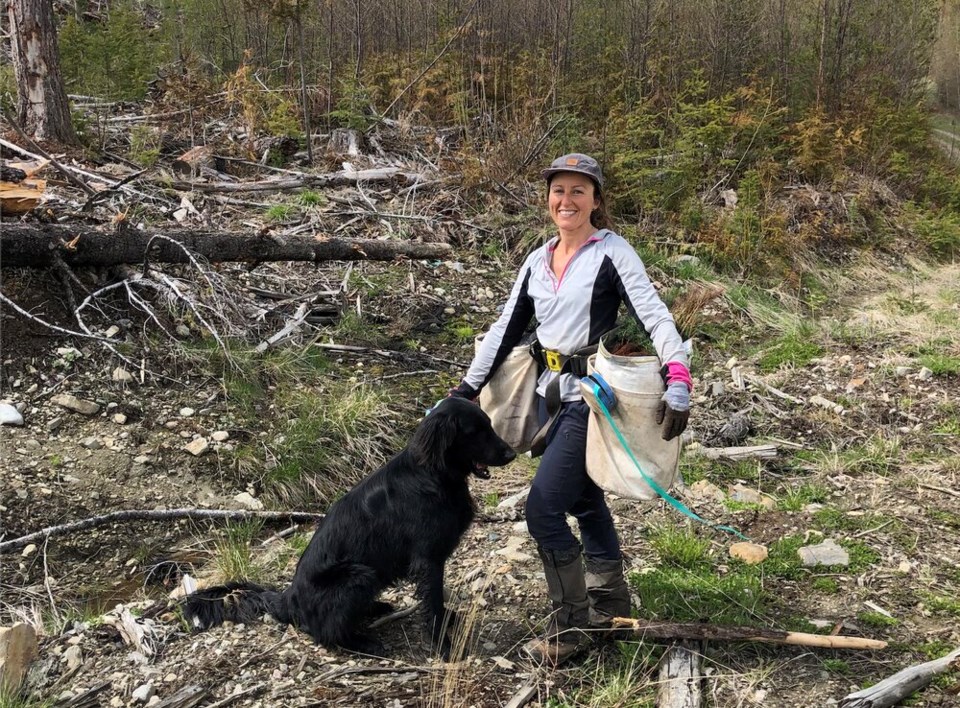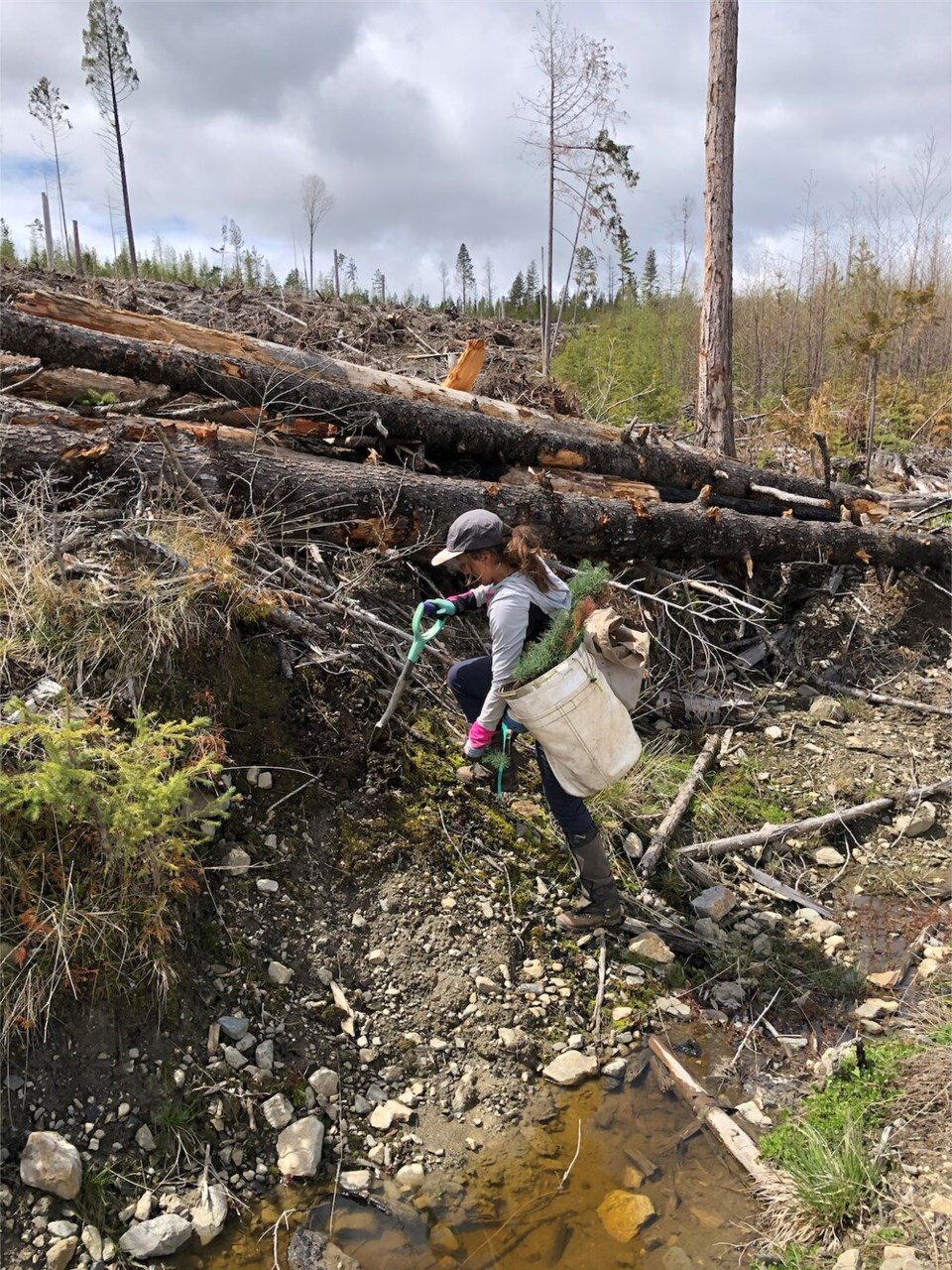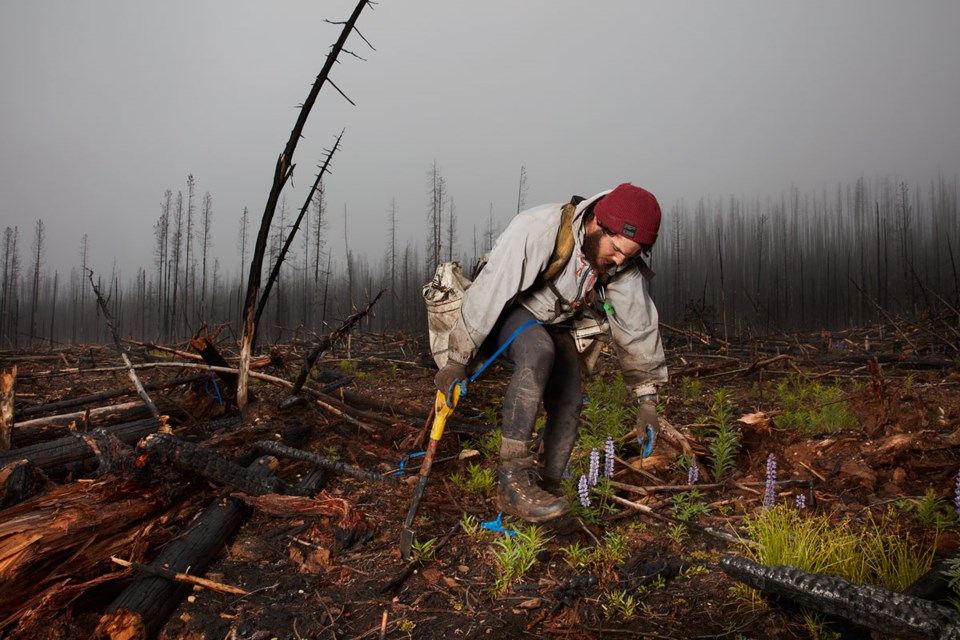When Alison Long first heard you could plant trees for a living, she was still a teenager. Many of her friends were getting jobs at the mall in retail outlets like The Bay — a nightmare scenario for Long.
So she faxed off her resume and soon stepped onto her first cut block to sink young tree seedlings into the soil.
“I just knew I wanted that kind of job,” she told Glacier Media.
Nearly two decades later, Long has two children and a husband. For much of the year, she works as an ambulance paramedic in what she describes as her “town job.” But the entire family keeps going back to plant trees for several months every season.
“There’s no other work that can really come close to that feeling,” she said.
Part of what Long loves is the camaraderie, the sense of being part of a team working hard day in, day out for months on end. Part of the draw is venturing out into nature across British Columbia.
“It keeps us fit,” she said after a day planting near Cherryville, B.C. “We love being outside.”
Then there’s the money. The job helped her and her husband put a down payment on a house in Courtenay on Vancouver Island. For others, tree planting offers a seasonal windfall, a ticket to live out the rest of the year travelling or to save for school.
But after 17 years heading into the bush, this is Long's last season — her oldest is getting ready to start school in the fall, making spring planting trips in the Monashee Mountains a challenging prospect. At 39, Long says she wants to stop using her body instead of her brain. And to make matters worse, this year, she expects the take-home pay to be much less.
“We’re really feeling the cost of gas and food. Just the trip over from the island — OK, there’s $3,000 gone,” she said.
Those rising costs of living combined with an increasingly open job market have some tree planting companies worried the Long's won't be the only ones not returning next season.
And as the federal government gets set to ramp up its plan to plant over the next decade, some worry the industry won't have enough people to carry out the hard work.

Demand for jobs tapered off 'dramatically'
This season, roughly 5,000 tree planters will fan out across British Columbia to repopulate cut blocks and replant forests charred by wildfire.
By the end of the season, those planters will have dropped an estimated 280 million seedlings into the ground, says John Betts, executive director of the Western Forestry Contractors' Association (WFCA).
It’s an industry that has traditionally relied on word of mouth to replenish its workforce — the promise to walk into an adventure and walk away with a lot of money by summer’s end.
But getting enough workers to plant those trees has become increasingly challenging.
Several tree planting companies Glacier Media spoke to said they had a hard time filling positions this year. Some attributed that to a wide-open job market, most to rising inflation.
“We were doing really well. We had lots of applications in February and March,” said Timo Scheiber, CEO of the New Westminster-based Brinkman Reforestation Ltd.
“Then it started to taper off — dramatically.”
Scheiber says his company ultimately filled the positions they needed to meet their contracts, but the “pickings were slim,” he said.
“Next year is the big challenge,” said Scheiber. “We’re already trying to face that.”
To bring in rookie planters, Scheiber says the industry needs to up the price paid per tree planted to at least keep up with inflation, something that can be difficult when rates are negotiated the fall before.
Without that, he says rising wages in other industries will continue to siphon off labour.
“It’s starting to lose its appeal financially because other jobs have increased their pay rates,” he said. “At a certain point, we’ll be unable to gear up properly.”
Jim Logan of Folklore Contracting, which employs up to 375 planters per year out of its Prince George offices, said he also worries about a “long-term decline in hiring” tree planters.
Jason Krueger, owner and CEO of Summit Reforestation in Smithers, said hiring was also on track across the country this year until about mid-February when applications “plummeted.”
“People just have lots of jobs. We got the positions filled but it was certainly leaner pickings,” he said. “It takes a special kind of person to go out and bend over 3,500 times a day.”
Roughly 40 per cent of Summit Reforestation’s planters are hired as first-time planters every year, with about a third travelling from Ontario, 20 per cent from Alberta and another third from B.C.
All of those workers have to fly or drive out on their own dime to get to work for the season at a time when soaring inflation pushed up Canada's consumer price index 6.8 per cent in April compared to a year earlier.
In May, Statistics Canada reported the price of groceries jumped 9.7 per cent — the largest increase since September 1981 — while gasoline prices were up 36.3 per cent year over year.
In response, Krueger said he has had “to beg” clients to pay more per tree in order to keep up with the rising cost of almost everything.
“If those trends continue until next year, the feds' two-billion tree program is going to be in trouble,” he said.

Not all employees feel rising costs in the same way. Veteran workers make hundreds of dollars a day more than first-year planters. That’s led many experienced planters to return in a boon for tree planting companies that rely more heavily on veteran workers, according to several companies who told Glacier Media their worker shortage was not as pressing.
“It’s not the same market as it was,” said Jeff Burns of Dynamic Reforestation in Williams Lake. “But we’re denying people constantly.”
For Gordon Saunders, a partner at Zanzibar Holdings — where Long is finishing up her last year — the company’s 42 years of experience has allowed it to build up a reputation.
As Long put it with a chuckle, her crew this year is “30 per cent old crusty faces.” The rest, she added, are in their mid-20s with five to seven years of experience.
Still, said Saunders, “We’ve had more cancellations this past year than any others.”
Saunders said the company managed to pick up more replacement planters at the last minute.
He suspects many potential workers chose to pursue jobs closer to home or go to university instead.
Shifting from fibre to carbon sink
The calculation to work or study closer to home could threaten what the WFCA’s Betts says is one of Canada’s most important workforces in the country’s effort to adapt to a changing climate.
For decades, the tree planting industry has been largely funded by wood harvesters as part of their legal duty to replant the province’s forests.
But as that industry declines, Betts sees federal government-backed contracts under the two-billion tree plan to fill the void.
Planting two billion trees over the next decade will cover 11,000 square kilometres, or an area nearly 96 times the area covered by the City of Vancouver, according to Natural Resources Canada, which manages the program.
Last year, the federal government funded the planting of 30 million trees — including more than 50 species at more than 500 sites — under the two-billion tree program. Whether those contracts fulfilled their goals will be revealed “in the coming weeks,” said ministry spokesperson Brian Naud.
As of February 2022, the government had received over 200 applications for funding during this year’s planting season, ranging from urban and suburban projects to mass planting schemes involving hundreds of thousands of trees.
“The program is still reviewing proposals and working as quickly as possible to get decisions made so that tree planting for the 2022 season can begin immediately,” said Naud.
“Once completed, we will have a better understanding of how many trees will be planted this year and in future years.”
Over the next two years, 2021's total is expected to double to 60 million trees, and by 2027, the number of trees planted per year is set to hit 320 million trees annually.
That 10-fold increase will require a massive effort — not just to plant the trees but to raise the seedlings in nurseries two to three years in advance so they’re ready to plant.
To receive funding, organizations or companies wanting to plant trees must secure labour to carry out their work, said Naud.
When asked whether the ministry recognizes declining interest from rookie tree planters, the spokesperson said it “understands that tree planting is a physically demanding occupation” and that it’s looking to monitor the “challenges” through funding applications as the years go by.
But some in the industry worry that not heading off the labour problem early could lead to backlogs as the program grows.
“We’ve already started the clock,” Scheiber warned. “It’s ticking.”
To attract enough labour to plant that many trees, Scheiber says the industry would have to up payouts to workers “aggressively.”
It’s all part of a transition the heads of some tree planting companies say is at the forefront of a shift from market-driven, fibre-focused planting to creating resilient forests that can withstand climate change — and the drought, fires and mountain pine beetle infestations that come with it.
Governments appear to be working hard to push in that direction, but Scheiber says it's not moving fast enough.
“The fires are still getting ahead of us. We’re still doing things the way we did them 20 years ago.”
Rebranding in an age of climate change
Like most tree planting companies, Krueger says Summit Reforestation relies on word of mouth to replenish its workforce.
“People need to go home happy and stoked so they tell all their friends,” he said. “If they go home and can’t make it past Christmas, we’re not going to have a workforce next year.”
Until now, more than half of tree planters in B.C. are students and most are white from middle-class backgrounds.
But the plan to plant two billion trees in the next decade will generate another 4,300 jobs across the country — including tree planters, staff to conduct monitoring and surveys, nursery labourers and seed collectors, according to Natural Resources Canada.
To recruit that many new people means moving away from the old hiring model.
When industry leaders get together for a summit this summer, WFCA's Betts says part of the conversation will centre around reaching out to a different kind of planter.
“Canada is not all white, middle-class people. It’s people from different races, different backgrounds. It’s Indigenous,” he said.
Betts said he and his colleagues are just starting to begin a rebranding of the tree planting industry in B.C., on social media and elsewhere, in a way that will attract a wider swath of Canadians.
“We’re in the middle of a marketing program. It’s something we’d never thought we’d have to do,” said Betts, who remains positive the government funding will usher in a new future of planting.
The selling points are there: adventure, money, a good camp life. Many parents tell Betts their children come back totally different people.
“We just have to tell our story. It’s just 'tell the truth.' A large proportion of Canadians will answer,” he said.
There have already been some hints the lifestyle could catch on more broadly. Betts points to a young woman, Nahanni Arntzen, who was born in a tree planting camp in Kingcome Inlet. From 1973 to 1986, the family travelled around the province — living out of tents, campers and makeshift saunas, all while planting 20 million trees.
When she posted a series of old Kodachrome slide films to , the response was overwhelming, said Betts (Arntzen has since published a of the old photos).
“It’s the authenticity,” said Betts. “They like the authenticity of what the '70s provided.”
Like Betts, Long is pragmatic about what the work has meant — more trees to cut down for harvesting companies in the future. At the same time, she says there are glimmers of something different.
“Some days we know we’re just part of the forestry — we’re just planning a crop,” she said. “But there’s this hope. A lot of what we’re planting takes at least 50 years to be harvested again.
“Hopefully, in the next generation, they will be left to grow.”
In this, Long's last year, that hope has been kept alive as roughly half the planting she has done runs through burn scars from last year’s fires.
“You’ll see just sticks of the forest. Just black sticks,” she said as her children called for her. “If what that means is we plant new areas to rewild, then that means something.”
As traditional extractive industries transform and more jobs offer a workday tethered to a computer, Betts says tree planting offers one of the few remaining frontier lifestyles — but one with a twist.
“This kind of work is making a difference for climate change,” said Betts, pointing to both a rise in wildfires and the power of trees to sequester carbon.
“We just have to find the people we need to save the world.”
Or as Long put it, quoting her husband, “Tree planting is one of the only jobs that makes sense today.”





